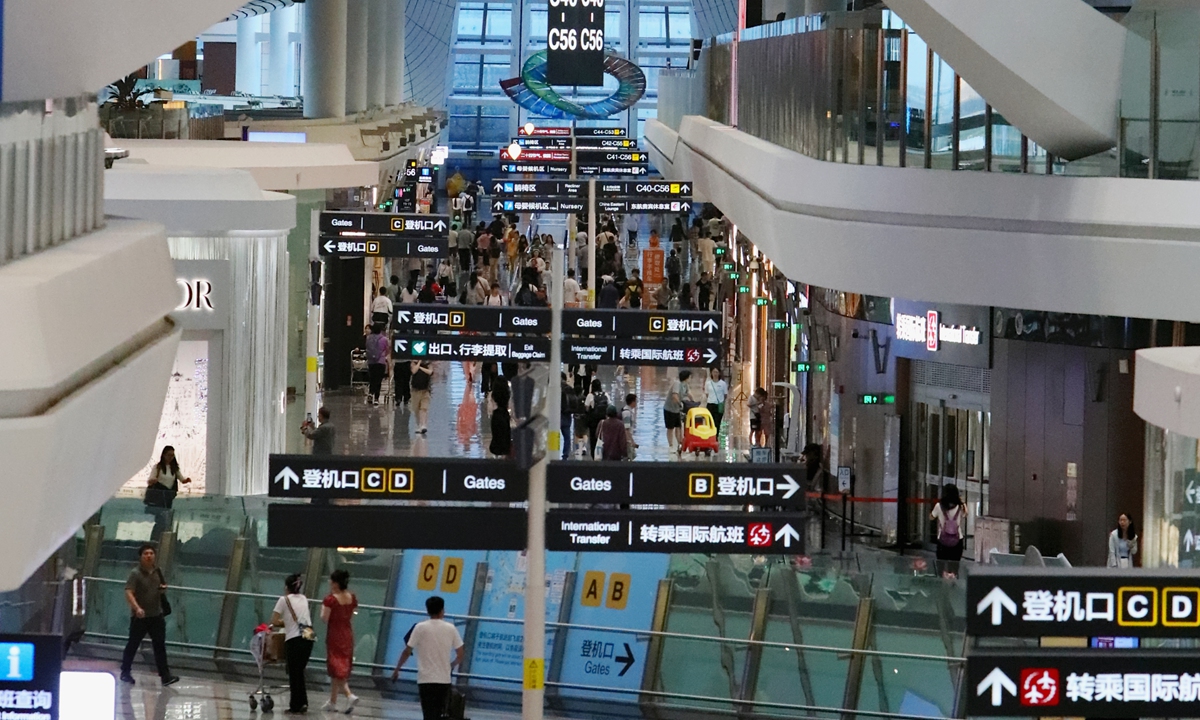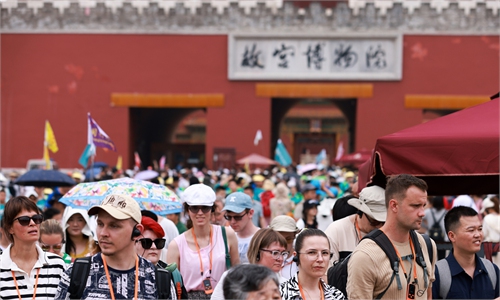
A view of Beijing Daxing International Airport Photo: Courtesy of Beijing Daxing International Airport
Chinese airports have witnessed a rising number of overseas travelers who came in enjoying the country's 144-hour visa-free transit policy, a clear sign reflecting the charm of China as a travel destination and the growing potential of Chinese aviation market.
As of Monday, the number of inbound and outbound travelers through Beijing Daxing International Airport reached 30.09 million passenger trips, representing growth of 31.85 percent over the same period last year. On Saturday, the airport facilitated a total of 1,083 flights and 180,000 inbound and outbound passengers, a record high since entering operation, the airport said on Tuesday.
The airport also said that, as of Monday, the number of overseas passengers exceeded 2.7 million, with more than 280,000 foreigners entering the country through the airport.
Outside of Beijing, Chengdu has also seen a rising number of overseas travelers.
The usage of cross-border payment code scanning to ride the subway in Chengdu, Southwest China's Sichuan Province increased by 177 percent year-on-year in July, and the cumulative passenger trips of local metro lines exceeded 200 million in the month, an increase of 11 percent month-on-month, according to Chengdu Fabu, the official social media account of the Chengdu government.
As of July 20, inbound and outbound personnel flow handled by Chengdu-based airlines surpassed three million, exceeding the whole of 2023.
The land entry and exit port of Shenzhen, South China's Guangdong Province saw more than 1.31 million inbound and outbound passenger trips over the first 11 days of August, up 28 percent year-on-year.
Daily flight volume and passenger traffic across Shanghai's two international airports, Pudong and Hongqiao, both hit record highs on Sunday as well.
Luke Serdar, a tourist from Australia, who recently travelled to several cities in China including Macao, Guangzhou, Xi'an and Beijing, told the Global Times that he has found "China actually to be a beautiful place to visit."
Although he obtained a visa before the 144-hour policy came into effect, he said the travelling was "amazing," adding that he would strongly recommend his close friend to visit China and take advantage of the 144-hour visa-free policy.
Market watchers said that the growth of inbound and outbound travelers was mainly due to the continued expansion of China's visa-free policy, a recovery of international flight capacity, and the cross-border consumption boom.
Daxing airport confirmed that a total of 65 domestic, foreign and regional airlines have set up operations at the airport, operating a total of 190 domestic and international air routes, covering 180 destinations and serving 21 countries and regions worldwide.
Data from industry information provider VariFlight revealed that about 80 percent of routes to Asia, Europe and Oceania from the Chinese mainland have resumed service, with some major routes such as to Singapore, the United Arab Emirates, and the UK continuing to enjoy strong growth.
The opening-up of China's tourism industry is an opportunity for the development of the world's aviation industry, Gong Yiting, head of branding department of VariFlight told the Global Times on Tuesday.
China's civil aviation is continuing to improve operational efficiency, while the Chinese government continues to open up wider, providing opportunities for the world's aviation industry, creating a unique window for global airlines, Gong noted.
China's National Immigration Administration announced on July 15 that the country's 144-hour visa-free transit policy has been expanded to three more entry ports, taking the number of Chinese ports covered by the policy to 37.
Foreign citizens from 54 countries including the US, Canada and the UK who enter China through the designated entry ports and who hold valid international travel documents and connecting tickets to a third country within 144 hours, will be allowed to stay in designated areas for tourism, business, and visiting relatives.




